1995 CADILLAC ELDORADO brake
[x] Cancel search: brakePage 147 of 395
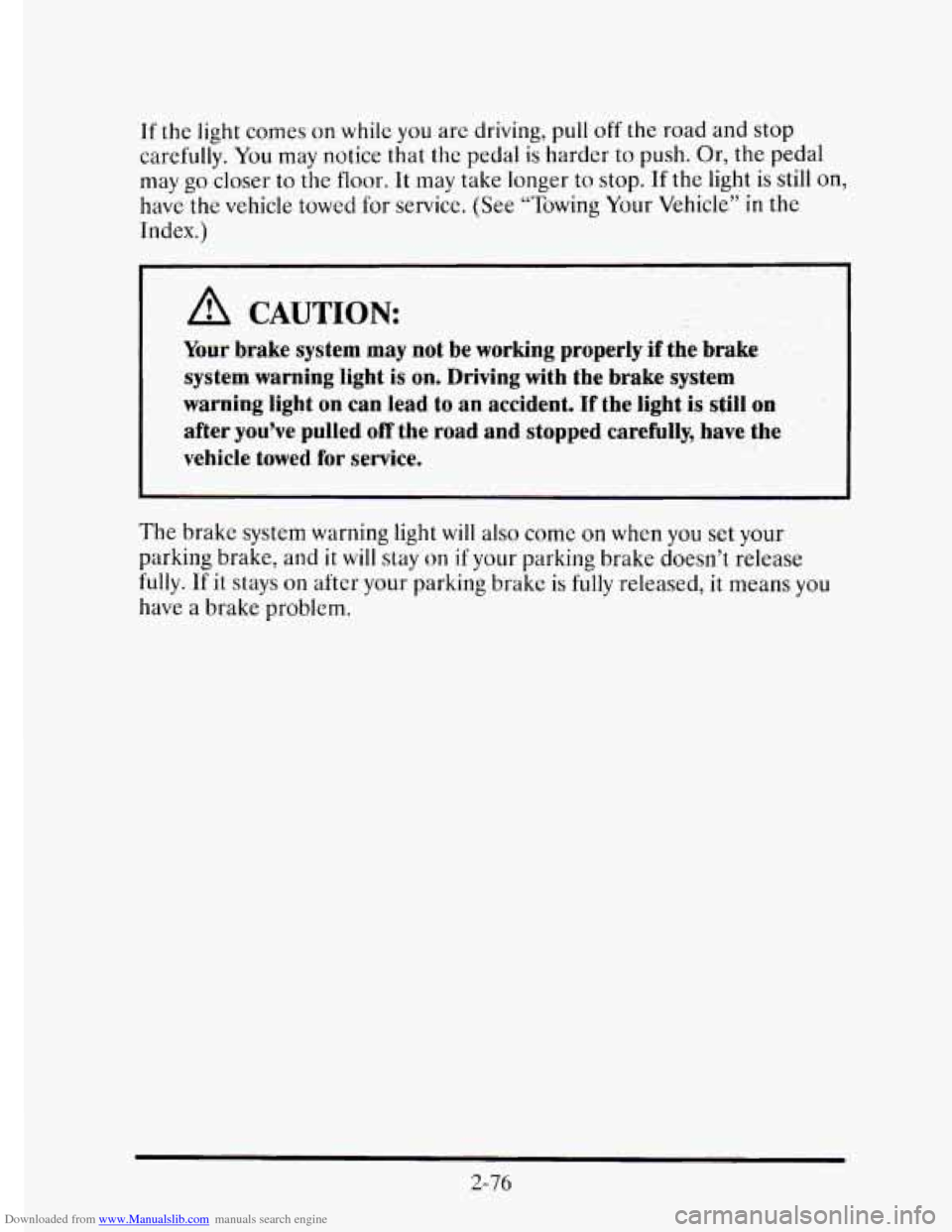
Downloaded from www.Manualslib.com manuals search engine If the light comes on while you are driving, pull off the road and stop
carefully. You may notice that the pedal is harder to push. Or, the pedal
may go closer
to the floor. It may take longer to stop. If the light is still on,
have
the vehicle towed for service. (See “Towing Your Vehicle’’ in the
Index.)
A CAUTION:
Your brake system may not be working properly if the brake
system warning light is on. Driving with the brake system
warning light
on can lead to an accident. If the light is still on
after
you’ve pulled off the road and stopped carefully, have the
vehicle towed
for service.
The brake system warning light will also come on when you set your
parking brake, and
it will stay on if your parking brake doesn’t release
fully. If it stays on after your parking brake is fully released, it means you
have a brake problem.
2-76
Page 148 of 395

Downloaded from www.Manualslib.com manuals search engine Anti-Lock Brake System Warning Light
ANTI-
LOCK (@)
With the anti-lock brake system, this light will come on when you start
your engine and may stay
on for several seconds. That’s normal. If the
light doesn’t come on, have it fixed
so it will be ready to warn you if there
is a problem.
If the light stays on, turn the ignition off. Or, if the light comes on when
you’re driving, stop as soon as possible and turn the ignition
off. Then
start the engine again
to reset the system. If the light still stays on, or
comes on again while you’re driving, your Cadillac needs service. If the
regular brake system warning light isn’t
on, you still have brakes, but you
don’t have anti-lock brakes. If the regular brake system warning light is
also on,
you don’t have anti-lock brakes and there’s a problem with your
regular brakes. See “Brake System Warning Light” earlier
in this part.
Traction Disabled Message
If this message is displayed, there’s a problem with your traction control
system and your vehicle needs service. When this message
is displayed,
the system
will not limit wheel spin. Adjust your driving accordingly.
Traction Control System Active Message
When your traction control system is limiting wheel spin, the TRACTION
ACTIVE message will be displayed. Slippery road conditions may exist if
this message is displayed, so adjust your driving accordingly. This message
will stay
on for a few seconds after the traction control system stops
limiting wheel spin.
2-77
Page 157 of 395
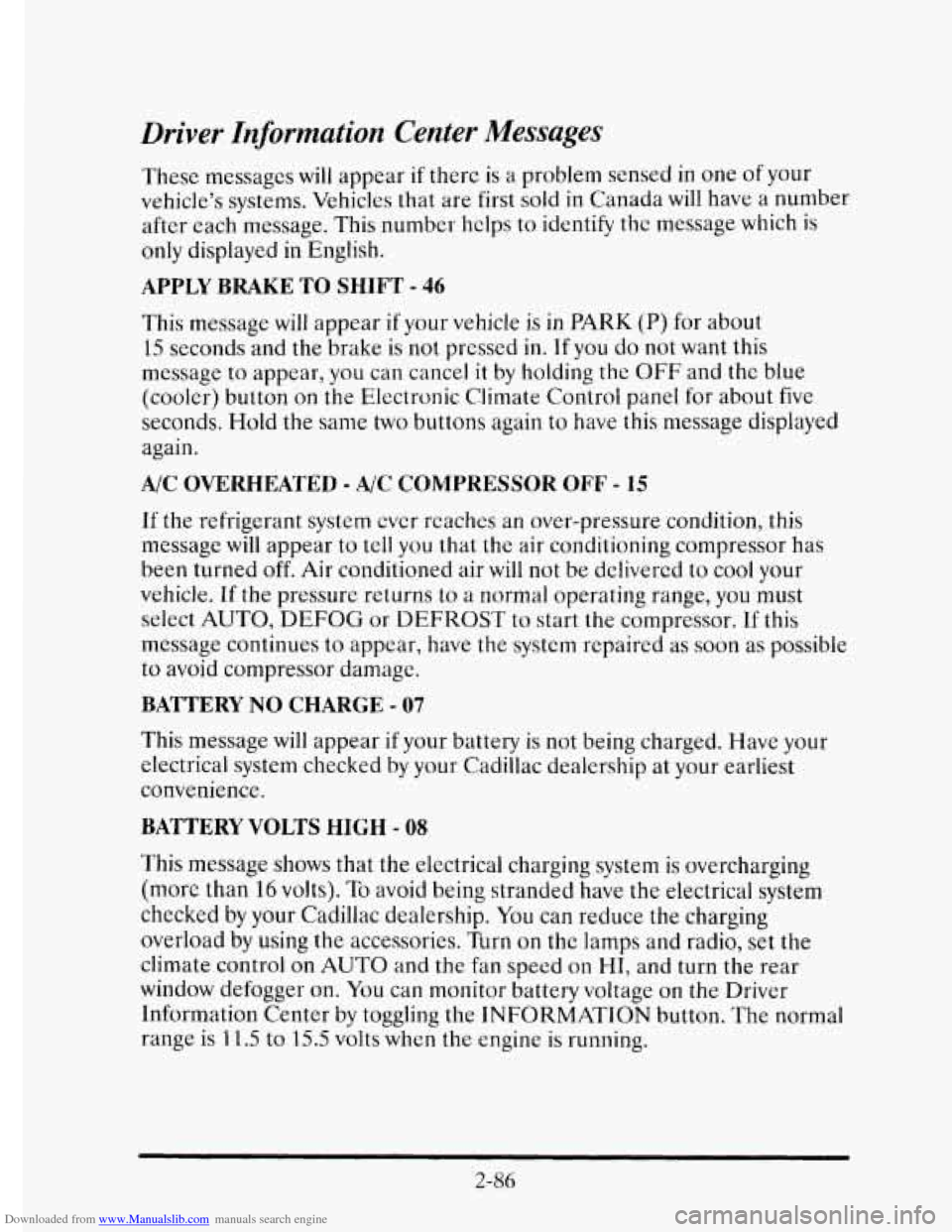
Downloaded from www.Manualslib.com manuals search engine Driver Information Center Messages
These messages will appear if there is a problem sensed in one of your
vehicle’s systems. Vehicles
that are first sold in Canada will have a number
after each message.
This number hclps to identify the message which is
only displayed in English.
APPLY BRAKE TO SHIFT - 46
This message will appear if your vehicle is in PARK (P) for about
15 seconds and
the brake is not pressed in. If you do not want this
message
to appear, you can cancel it by holding the OFF and the blue
(cooler) button on
the Electronic Climate Control panel for about five
seconds. Hold the same
two buttons again to have this message displayed
again.
A/C OVERHEATED - A/C COMPRESSOR OFF - 15
If the refrigerant system ever rcaches an over-pressure condition, this
message
will appear to tell you that the air conditioning compressor has
been turned off. Air conditioned air
will not be delivered to cool your
vehicle.
If the pressure returns to a normal operating range, you must
select AUTO,
DEFOG or DEFROST to start the compressor. If this
message continues to appear, have the system repaired
as soon as possible
to avoid compressor damage.
BATTERY NO CHARGE - 07
This message will appear if your battery is not being charged. Have your
electrical system checked
by your Cadillac dealership at your earliest
convenience.
BATTERY VOLTS HIGH - OS
This message shows that the electrical charging system is overcharging
(more than
16 volts). To avoid being stranded have the electrical system
checked by your Cadillac dealership.
You can reduce the charging
overload by using the accessories.
Turn on the lamps and radio, set the
climate control
on AUTO and the fan speed on HI, and turn the rear
window defogger on.
You can monitor battery voltage on the Driver
information Center by toggling the INFORMATION button. The normal
range is 1 1.5
to 15.5 volts when the engine is running.
2-86
Page 158 of 395
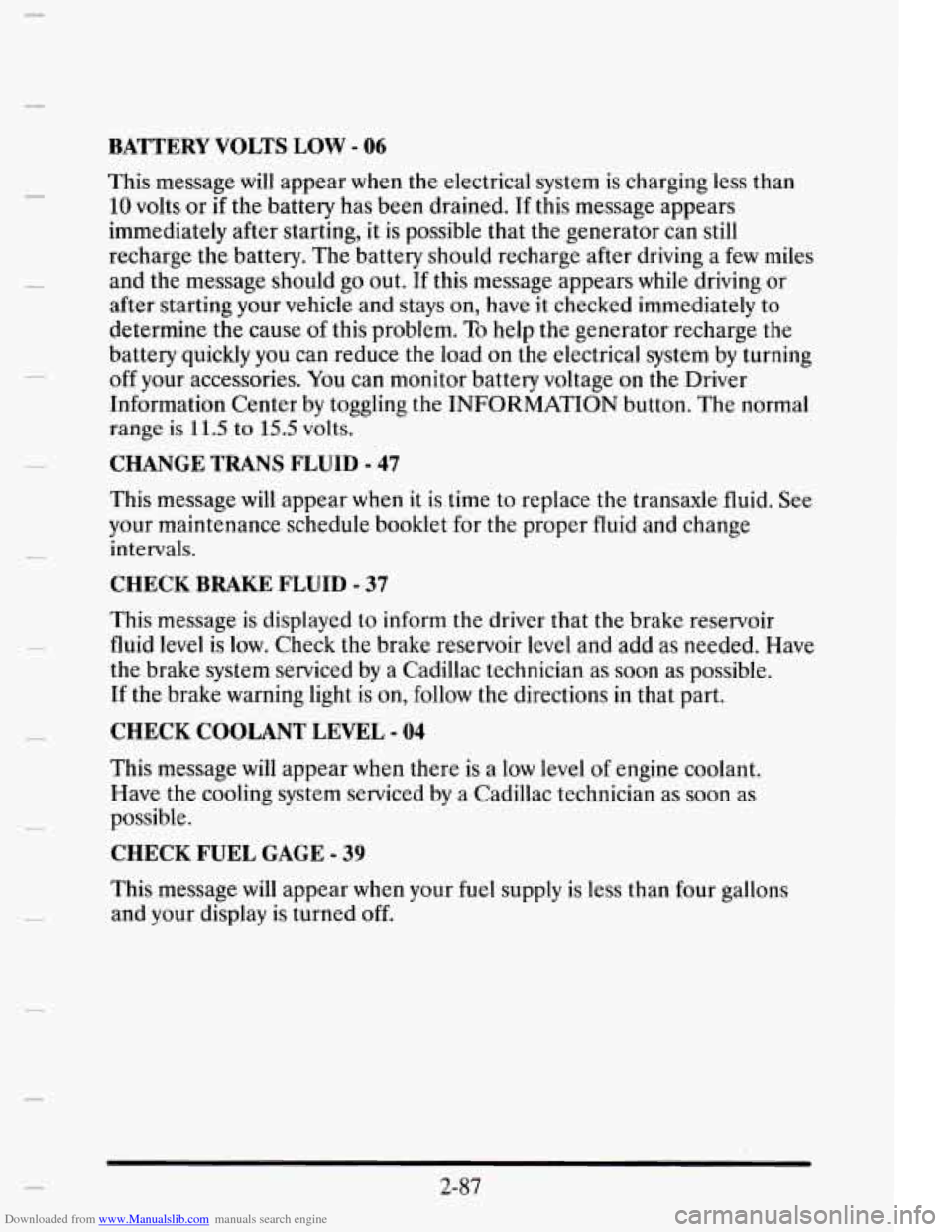
Downloaded from www.Manualslib.com manuals search engine BATTERY VOLTS LOW - 06
This message will appear when the electrical system is charging less than
10 volts or if the battery has been drained. If this message appears
immediately after starting,
it is possible that the generator can still
recharge the battery. The battery should recharge after driving a few miles
and the message should go out. If this message appears while driving or
after starting your vehicle and stays on, have
it checked immediately to
determine the cause
of this problem. To help the generator recharge the
battery quickly you can reduce the load on the electrical system by turning
off your accessories. You can monitor battery voltage on
the Driver
Information Center by toggling the
INFORMATION button. The normal
range
is 11.5 to 15.5 volts.
CHANGE TRANS FLUID - 47
This message will appear when it is time to replace the transaxle fluid. See
your maintenance schedule booklet for the proper fluid and change
intervals.
CHECK BRAKE FLUID - 37
This message is displayed to inform the driver that the brake reservoir
fluid level is low. Check
the brake reservoir level and add as needed. Have
the brake system serviced by a Cadillac technician as soon as possible.
If the brake warning light is on, follow the directions in that part.
CHECK COOLANT LEVEL - 04
This message will appear when there is a low level of engine coolant.
Have the cooling system serviced by a Cadillac technician as soon as
possible.
CHECK FUEL GAGE - 39
This message will appear when your fuel supply is less than four gallons
and your display is turned off.
2-87
Page 188 of 395
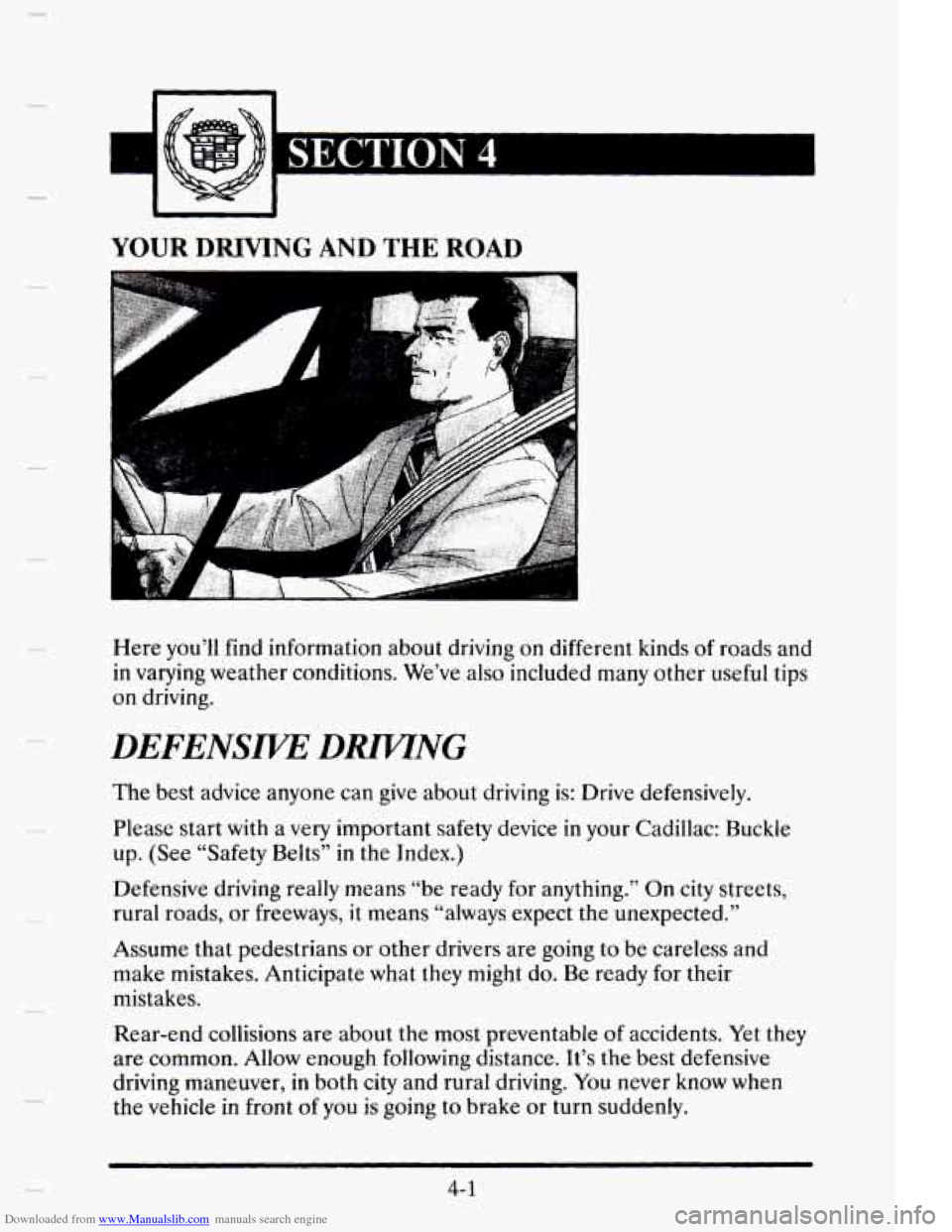
Downloaded from www.Manualslib.com manuals search engine c
c
-
YOUR DRIVING AND THE ROAD
Here you’ll find information about driving on different kinds of roads and
in varying weather conditions. We’ve also included many other useful tips
on driving.
DEFENSMY DRIVTNG
The best advice anyone can give about driving is: Drive defensively.
Please start with a very important safety device
in your Cadillac: Buckle
up. (See “Safety Belts” in the Index.)
Defensive driving really means “be ready for anything.” On city streets,
rural roads, or freeways,
it means “always expect the unexpected.”
Assume that pedestrians or other drivers are going to be careless and
make mistakes. Anticipate what they might do. Be ready
for their
mistakes.
Rear-end collisions are about the most preventable
of accidents. Yet they
are common. Allow enough following distance. It’s the best defensive
driving maneuver,
in both city and rural driving. You never know when
the vehicle
in front of you is going to brake or turn suddenly.
4- 1
Page 192 of 395

Downloaded from www.Manualslib.com manuals search engine CONTROL OF A VEHICLE
You have three systems that make your vehicle go where you want it to go.
They are the brakes, the steering and the accelerator. All three systems
have to do their work at the places where the tires meet the road.
. . ..-
Sometimes, as when you’re driving on snow or ice, it’s easy to ask more of
those control systems than the tires and road can provide. That means you
can lose control
of your vehicle.
BRAKING
Braking action involves perception time and reaction time.
First, you have to decide
to push on the brake pedal. That’sperception
time. Then you have to bring up your
foot and do it. That’s reaction time.
Average reaction time is about
314 of a second. But that’s only an average.
It might be less with one driver and as long as
two or three seconds or
more with another.
Age, physical condition, alertness, coordination, and
eyesight all play a part.
So do alcohol, drugs and frustration. But even in
3/4 of a second, a vehicle moving at 60 mph (100 km/h) travels 66 feet
(20 m). That could be a lot of distance in an emergency, so keeping
enough space between your vehicle and others is important.
And,
of course, actual stopping distances vary greatly with the surface of
the road (whether it’s pavement or gravel); the condition of the road (wet,
dry, icy); tire tread; and the condition
of your brakes.
4-5
Page 193 of 395
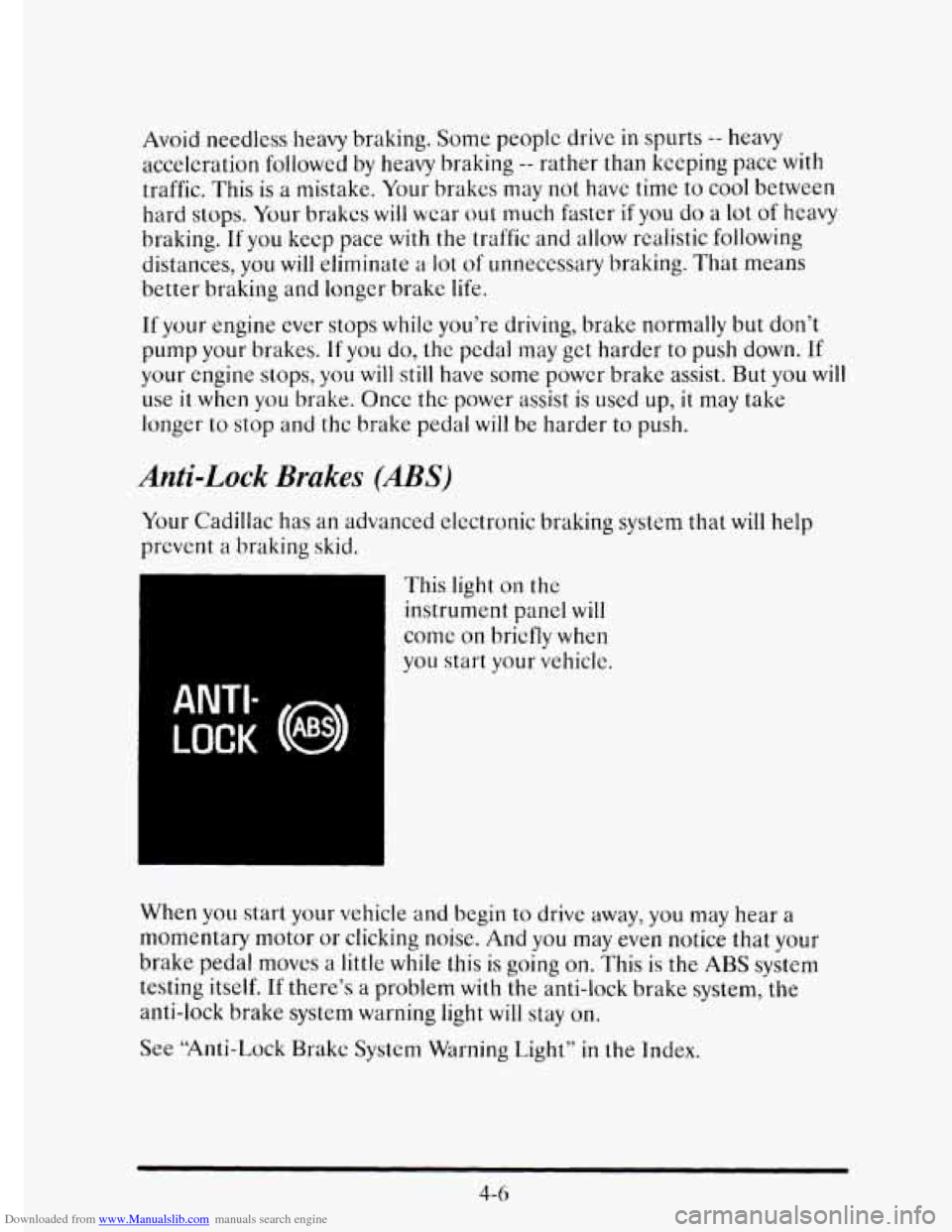
Downloaded from www.Manualslib.com manuals search engine Avoid needless heavy braking. Some peoplc drive in spurts -- heavy
acceleration followed by heavy braking
-- rather than keeping pace with
traffic. This is a mistake. Your brakes may
not have time to cool between
hard stops.
Your brakes will wear out much faster if you do a lot of heavy
braking. If you keep pace with the traffic and allow realistic following
distances,
you will eliminate a lot of unnecessary braking. That means
better braking and longer brake
life.
If your engine ever stops while you’re driving, brake normally but don’t
pump your
brakes. If you do, the pedal may get harder to push down. If
your engine stops, you will still have some power brake assist. But you will
use it when you brake. Oncc thc power assist is used up, it may take
longer to stop and the brake pedal
will be harder to push.
Anti-Lock Brakes (ABS)
Your Cadillac has an advanced electronic braking system that will help
prevent
a braking skid.
ANTI-
LOCK (@)
This light on the
instrument panel will
come on briefly when
you start your vehicle.
When
you start your vehicle and begin to drive away, you may hear a
momentary motor
or clicking noise. And you may even notice that your
brake pedal mows a little while this is going
on. This is the ABS system
testing itself.
If there’s a problem with the anti-lock brake system, the
anti-lock brake system
warning light will stay on.
See “Anti-Lock Brakc System Warning Light”
in the Index.
4-6
Page 194 of 395

Downloaded from www.Manualslib.com manuals search engine Here’s how anti-lock works. Let’s say the road is wet. You’re driving
safely. Suddenly an animal jumps out
in front of you.
You slam on the brakes. Here’s what happens with ABS.
A computer senses that wheels are slowing down. If one of the wheels is
about to stop rolling, the computer will separately work the brakes at each
front wheel and at the rear wheels.
The anti-lock system can change the brake pressure faster than any driver
could. The computer
is programmed to make the most of available tire
and road conditions.
4-7